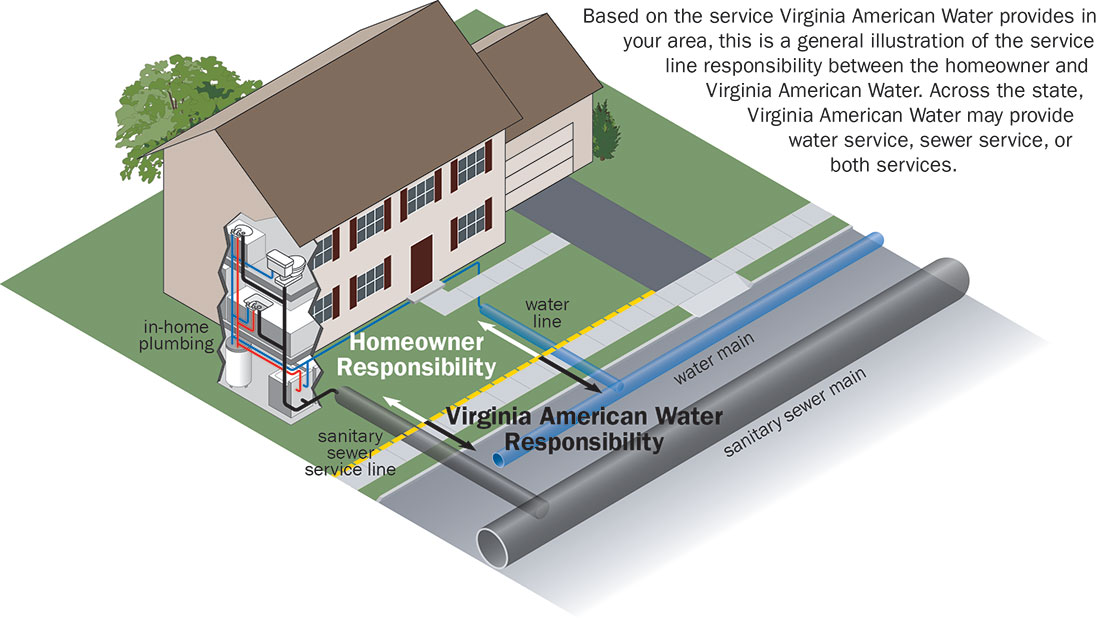RIGHTS & RESPONSIBILITIES
As a customer of Virginia American Water, you have the right to know how to get the best service from your water utility. We recognize the trust you place in us to provide high-quality, reliable drinking water. It is a responsibility that defines what we do as your local water company.
Our employees conduct an extensive treatment and monitoring program to ensure your water meets all state and federal drinking water regulations. Our water quality reports will help you learn more about water quality in your area.
Good water service goes beyond providing high-quality water. Whether we are starting up service, providing bill payment options, or helping you to understand your responsibilities regarding your internal plumbing and meter accessibility, our goal is to keep you informed, 24 hours a day, 7 days a week.
If you have questions about your rights and responsibilities as a customer, please contact our Customer Service Center at 1-800-452-6863. If your question is not resolved to your satisfaction, you have the right to contact the Virginia State Corporation Commission at 1-800-552-7945.
Virginia State Corporation Commission (Virginia SSC)
Tyler Building
1300 East Main Street
Richmond, Virginia 23219
1-804-371-9967 (main)
1-804-371-9677 (complaint)
1-800-552-7945 (in-state toll-free)
Virginia State Corporation Commission
What Equipment is Your Responsibility?

Much of the equipment we use to provide water and wastewater service is located beneath the ground, and it can be difficult for customers to determine what equipment is their responsibility and what equipment is American Water’s responsibility. The following descriptions explain the facilities and equipment used to provide water and wastewater service to your property.
Company Water Service Line. Owned and maintained by the company, this service line extends from the water main to the curb stop or curb line.
Company Sanitary Sewer Main. A sanitary sewer main is a pipe located in the street, back easement or side easement that is designed solely to transport wastewater from homes and businesses to the wastewater treatment plant. Sanitary sewers in your neighborhood are owned, operated and maintained by the company.
Curb Stop. Owned and maintained by the company, the curb stop is a valve that can be opened and closed to control the supply of water to the property.
Meter. Owned and installed by the company, this device is used to measure water consumption at the customer’s property. Although the meter is owned by the company, the customer is responsible for providing an adequate location for the meter, making it accessible and assuring that it is protected from damage, including damage caused by freezing.
Customer Water Service Line. Owned and maintained by the customer, this service line extends from the curb stop or curb line to the building.
Meter Pit. Owned and maintained by the Company for single meters, sizes up to 2" in diameter. This structure is constructed by the Company to house the water meter outside of the customer’s home at an underground location. Customers are responsible for keeping the pit visible and for all the plumbing within the pit. The illustration shows a meter in the home, so the meter pit is not shown.
Pressure Reducing Valve (PRV). Owned, installed and maintained by the customer, this device is designed to reduce water pressure within the customer’s home if the pressure of the company’s distribution system exceeds a certain threshold set by the plumbing code (typically 60 pounds per square inch). Please be aware that pressure may be higher in some areas due to elevation changes and operating requirements. Installing a PRV might increase the life of internal plumbing fixtures and piping. A plumber can verify the pressure in your home and determine whether a PRV should be installed as part of your household plumbing.
Customer Sanitary Sewer Service Line. Owned and maintained by the customer, the sanitary sewer service line extends from the property line to the building. Your maintenance responsibilities include, but are not limited to, the intrusion of tree roots into the sewer service line. Also, you are responsible for the proper maintenance of all plumbing within the home, including removal of any unauthorized connections.
What are unauthorized sanitary sewer connections? Unauthorized connections are downspouts, sump pumps, footing tiles, drains from window wells, and drains from driveways that introduce storm water into the sanitary sewer system. These connections are strictly prohibited.
Cleanout. A cleanout is an access point in the sanitary sewer service line which allows a plumber to clear out obstructions in the line. Not all homes have a cleanout. Cleanouts are owned and maintained by the homeowner.
